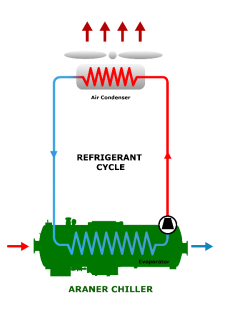Have you ever imagined that there was a time when district cooling systems did not exist? It is even harder to imagine how life would be without this technology. Industry and developments would require full support of the grid and miss solutions offered by renewables and waste heat, among other benefits. There is no doubt that district cooling is essential today, so is getting it right when choosing or handling the condensing unit of the network. What role do condensing units play in the effective performance of a DC network?
Condensing for District Cooling
The list of components that make up a district cooling plant includes chillers, pumping stations, cooling towers, TES facilities and electrical substations. Others are auxiliary equipment, piping, switch-gear and systems control. An important system to include in the plant is condenser cooling, which the provider may offer with alternatives. DC relies on three major types of condensing units: air-cooled, water-cooled and evaporative condensers. In a DC system, a central plant provides many buildings with cool water through a network of underground pipework. Heat exchangers sit between the distribution network and the buildings. Their purpose is to aid the rejection of heat extracted from the chilled water and heat from the vapor compression cycle or absorption chiller to a separate circuit of water (for water-cooled) or to ambient air (for air-cooled).
Types of Condensing Units
It might appear like settling for any condensing unit in a district cooling system is a straightforward process, but there are several options to consider out there. What this means is that the selection process can be overwhelming, particularly considering the capital importance of these devices. The condensing unit world offers a lot, some of which you may not know. Some may be helpful in some instances, while others may not. Many terms come up for this kind of discussion, some of which might be confusing. Examples are air-cooled condensers, river water-cooled, cooling towers, etc. Perhaps, the following discussion about condensing units for district cooling systems makes matters a bit simpler to place unit against its benefits.
Air Cooled Condenser

With all its benefits, a water-cooled condenser can be inapplicable in many regions suffering from widespread shortage of fresh water. Running water to waste is unthinkable for such countries because condensers demand volumes of water. That is why another version- air-cooled condenser- makes so much sense in many instances. In this setup, ambient air is the main driver for refrigerant cooling and cycling. The general design of this condenser is the movement of ambient air over the exterior of finned tubes, thus cooling a circulating fluid. The less overall maintenance requirement is one of the attractive characteristics of air-cooled condenser. This system may only demand maintenance utmost twice annually, unlike water-cooled condenser that demands much keener attention. This condenser offers flexibility for plot plan arrangement and plant location. The process or equipment requiring cooling does not have to be near a source of water. Furthermore, the lack of auxiliary water supply means that the environmental impact is lower. For these reasons, air cooled condensers are becoming more prevalent in district cooling systems. For an equal heat transfer level, these devices offer more economic benefits as compared to water-cooled condensers. In case performance dwindles, various improvement methods exist including inner pipe surface enhancement and tube geometry adjustment.
Water Cooled Condenser: Cooling Tower

Heat from a process or building served by a district cooling system must be dealt with through either heat recovery or heat rejection. The water-cooled condenser works together with the cooling tower for circulation of heat to the outside. You would use this system if you were after overall better efficiencies. Since this system consumes less overall power, this can translate to less energy consumption and costs. Owing to the high efficiency and minimal weather exposed components, water-cooled condenser is capable of lasting longer, as long as maintenance is done correctly. In addition, this condenser can operate in manufacturing industries or other high temperature areas.
Sea Water Cooled Condenser

For systems located near the sea, using the vast amount of water to reject heat is viable and cost effective option. Apart from energy savings, the method is also eco-friendly. However, the inevitable need to design this technology for the harsh sea conditions means that initial cost implication can be a challenge. Suitable materials for the high corrosive environment, such as titanium, are needed increasing the total cost of the project. However, ARANER has developed very cost-effective solution for sea water cooled chillers. The good thing is that the enormous savings in energy can help you recoup the initial cost within a few years.
It is evident that each condensing technology for district cooling presents merits and demerits, so it would be a lie to identify one as the best of the three condensing units. However, it emerges that any of the units could be the ideal solution if it satisfies your needs for efficiency, cost, and space, mode of operation and refrigeration plant size. The design team at ARANER will always check individual requirements of a project and suggest the best technology because all options offer capital importance if applied correctly.










